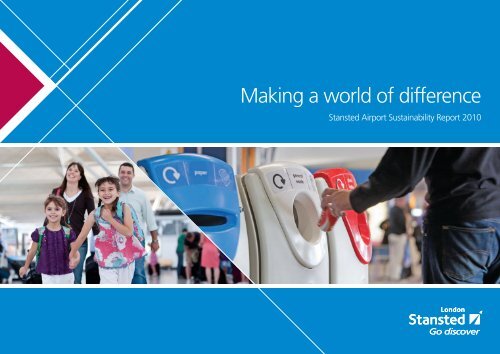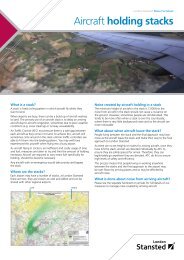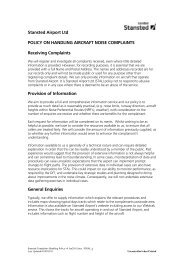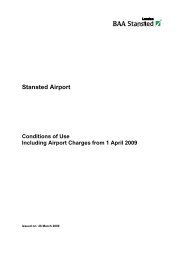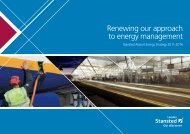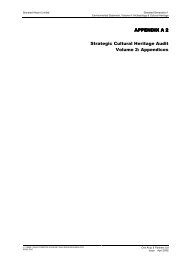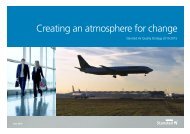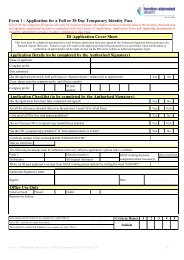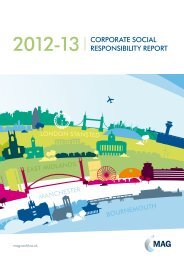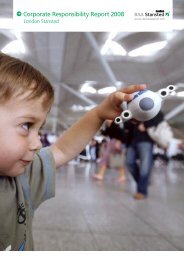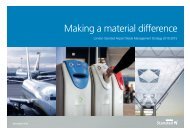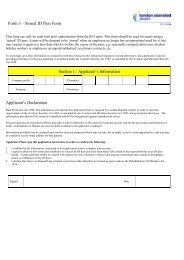corporate responsibility report - London Stansted Airport
corporate responsibility report - London Stansted Airport
corporate responsibility report - London Stansted Airport
You also want an ePaper? Increase the reach of your titles
YUMPU automatically turns print PDFs into web optimized ePapers that Google loves.
Making a world of difference<br />
<strong>Stansted</strong> <strong>Airport</strong> Sustainability Report 2010
Contents<br />
“<strong>Stansted</strong> <strong>Airport</strong><br />
is proud to hold<br />
both the ISO14001<br />
environmental accreditation<br />
and the Carbon Trust Standard”<br />
Message from the Managing Director 3<br />
1. Independent assurance statement 5<br />
2. Managing sustainability at <strong>London</strong> <strong>Stansted</strong> <strong>Airport</strong> 9<br />
3. Performance results 11<br />
4. Managing our carbon emissions 13<br />
5. Examples of what we do 15<br />
6. 2011 targets 21<br />
7. Data summary 23<br />
2
Message from the Managing Director<br />
I am delighted to introduce <strong>London</strong> <strong>Stansted</strong> <strong>Airport</strong>’s latest<br />
Sustainability Report.<br />
This document sets out how we have performed across a range<br />
of sustainability targets we set ourselves for 2010 and includes<br />
an independent external assurance review. The results of this<br />
and feedback from our stakeholders has shaped our 2011<br />
Sustainability targets.<br />
Our sustainability commitments are to:<br />
• Enhance the local, regional and national economic and<br />
social benefits of <strong>London</strong> <strong>Stansted</strong><br />
• Seek to prevent, reduce or offset <strong>London</strong> <strong>Stansted</strong>’s effects<br />
on the environment and local communities, and work with<br />
our stakeholders to ensure that the airport plays its role in<br />
respecting environmental limits<br />
• Provide good conditions of employment, respect diversity<br />
and equal opportunity for all employees<br />
• Provide a safe and secure airport for staff and passengers<br />
• Demonstrate effective and efficient management of<br />
<strong>London</strong> <strong>Stansted</strong>’s infrastructure and facilities.<br />
2010 was a challenging year for the business, as we responded<br />
to the effects of the volcanic eruption in Iceland, sustained<br />
challenging economic conditions, new government policies<br />
in the UK and the severe winter weather in both January<br />
and December.<br />
Despite these challenges, at <strong>Stansted</strong> we have continued to<br />
make positive steps on reducing our environmental impacts<br />
and engaging with the community to balance the needs of<br />
running an international airport, whilst minimising the impact it<br />
has on the communities surrounding the airport.<br />
We remain committed to operating the airport sustainably.<br />
We will be clear with both our business partners and local<br />
communities on our commitments as we have already set out<br />
in our five year plans on the following topics:<br />
• Employment<br />
• Noise<br />
• Air Quality<br />
• Waste<br />
• Surface Access<br />
During 2010, I was pleased to see the improvements we made<br />
to deliver these strategies, making the airport more sustainable.<br />
Key highlights for me have been the introduction of the<br />
new <strong>Stansted</strong> Express trains, the airport being re-accredited for<br />
the ISO 14001 award and achieving the Carbon Trust Standard<br />
as well as our ongoing community related activities.<br />
I note with interest the comments made by our independent<br />
assurance auditors to this <strong>report</strong> and I am committed to taking<br />
their points on board to improve our work in 2011.<br />
I believe the key for <strong>London</strong> <strong>Stansted</strong> <strong>Airport</strong> and all our<br />
stakeholders is improved partnerships with a view to work<br />
in collaboration.<br />
I hope you will enjoy reading this <strong>report</strong>.<br />
Nick Barton<br />
Managing Director, <strong>London</strong> <strong>Stansted</strong> <strong>Airport</strong><br />
<strong>Stansted</strong> <strong>Airport</strong> | Sustainability Report 2011 | August 2011 3
1<br />
“The targets in the<br />
Sustainability Report 2010<br />
demonstrate continuing<br />
progress for <strong>London</strong> <strong>Stansted</strong>”<br />
4
Independent assurance statement<br />
Introduction<br />
WSP Environment & Energy (WSP) were commissioned<br />
by <strong>Stansted</strong> <strong>Airport</strong> Limited (<strong>London</strong> <strong>Stansted</strong>) to conduct<br />
an independent external assurance review of the targets<br />
contained in the Sustainability Report 2010 and carbon<br />
footprint for 2010.<br />
The aim of this statement is to provide assurance to<br />
stakeholders, that the information provided by <strong>London</strong><br />
<strong>Stansted</strong> in the <strong>report</strong>ing information, is appropriate to the<br />
nature and activities of <strong>London</strong> <strong>Stansted</strong>’s operations as<br />
well as accurate, reliable, objective and has been validated<br />
by an independent third party. This statement also provides<br />
verification of <strong>London</strong> <strong>Stansted</strong>’s carbon footprint.<br />
Our assurance <strong>responsibility</strong><br />
WSP’s obligation is to <strong>London</strong> <strong>Stansted</strong>’s stakeholders and<br />
readers of this statement. WSP is responsible exclusively for<br />
the contents of this statement and providing assurance over<br />
the scope of data contained in the Sustainability Report 2010;<br />
specifically key performance indicators and targets, and carbon<br />
verification as detailed in the methodology.<br />
WSP has not been involved in the development of <strong>London</strong><br />
<strong>Stansted</strong>’s Sustainability Strategy, Carbon Footprint or<br />
preparation of any of the material included in the <strong>report</strong>ing<br />
information.<br />
Reporting criteria and assurance standards<br />
We performed our work in accordance with WSP’s assurance<br />
methodology which is based on the international assurance<br />
and audit standards ISO19011, ISO14064:3 and AA1000AS.<br />
We also referred to the WBCSD/WRI GHG Protocol and<br />
the DEFRA/DECC Corporate GHG Reporting Guidance in<br />
conducting our assurance work.<br />
Assurance methodology<br />
WSP undertook a review of the targets and key performance<br />
indicators included in the 2010 Sustainability <strong>report</strong>, excluding<br />
passenger experience and economic development key<br />
performance indicators (KPIs). A review was undertaken of<br />
the data collection, collation and conversion factors used for<br />
the carbon footprint. Of particular importance is to provide<br />
the assurance of materiality of the <strong>report</strong>ing information and<br />
engagement of stakeholders:-<br />
Materiality:<br />
The <strong>report</strong>ing information includes targets that are material<br />
to the wide range of <strong>London</strong> <strong>Stansted</strong>’s stakeholders and is<br />
considered by senior management in strategic development<br />
through the Sustainability Board.<br />
Inclusivity:<br />
The targets provide comprehensive coverage of key issues<br />
and challenges facing the airport and the aviation sector and<br />
<strong>London</strong> <strong>Stansted</strong> have engaged a number of internal and<br />
external stakeholders within this process.<br />
Responsiveness to stakeholder concerns:<br />
Engagement with stakeholders is evidenced in meeting<br />
the targets, with evidence of continuing collaboration with<br />
numerous working groups and partnerships to address the<br />
sustainability challenges.<br />
Our assurance process included:<br />
• Validation of all KPIs and sustainability targets in<br />
the <strong>report</strong>ing information (excluding the passenger<br />
experience and economic development)<br />
• Validation of processes for data collection methods<br />
• Validation of performance including alignment with key<br />
material risks and interviews with key personnel<br />
• A sample based validation of sustainability practices<br />
• Assessment of the carbon footprint to ensure compliance<br />
with the requirements of the GHG Protocol<br />
• Comments on materiality, representation and whether<br />
it meets GHG Protocol and ISO14064:1 and any errors<br />
or omissions and associated risks.<br />
<strong>London</strong> <strong>Stansted</strong> provided access to records and data<br />
required and WSP is confident that no material information<br />
has been withheld.<br />
In addition to this statement, an internal management <strong>report</strong><br />
was produced for <strong>London</strong> <strong>Stansted</strong>. This provides further<br />
details on the outcomes of our assurance and the key findings<br />
are summarised in this statement.<br />
<strong>Stansted</strong> <strong>Airport</strong> | Sustainability Report 2011 | August 2011 5
1<br />
Summary of<br />
key findings<br />
The targets in the sustainability<br />
Report 2010 demonstrate<br />
continuing progress for <strong>London</strong><br />
<strong>Stansted</strong> in managing and <strong>report</strong>ing on<br />
<strong>corporate</strong> <strong>responsibility</strong> issues. Highlights<br />
for 2010 include engagement with airlines<br />
to try new approaches to noise reduction, trials<br />
with alternative fuels for ground operations and<br />
significant on going investment in the airport’s water<br />
management infrastructure.<br />
• <strong>London</strong> <strong>Stansted</strong> is disclosing the key issues, opportunities<br />
and challenges facing the business for each topic area,<br />
which includes reference to the wider sustainability<br />
challenges facing the aviation sector. The airport has mature<br />
and developed sustainability management systems and<br />
programmes which continue to address these challenges<br />
• It is evident <strong>London</strong> <strong>Stansted</strong> is systematic in engagement<br />
with stakeholders, using diverse media to engage various<br />
groups. <strong>Stansted</strong> has developed a series of factsheets to<br />
help the local community understand about how flights,<br />
the airport and other aircraft operate<br />
• Overall <strong>London</strong> <strong>Stansted</strong> has achieved the majority of 2010<br />
targets as planned. For areas where targets have not been<br />
achieved or where only some progress has been made,<br />
an explanation or justification for this is provided in the<br />
Sustainability Report 2010<br />
• <strong>Stansted</strong> has published a Noise Action Plan in line with<br />
Government requirements. Although Government plans<br />
have been delayed, <strong>Stansted</strong> continued to develop the plan<br />
which sets out a key action plan which sets out a series<br />
of measures to ensure noise levels at the airport and most<br />
importantly, those emanating from aircraft on take off and<br />
approach are minimised<br />
• New measurement and data validation processes<br />
have meant that the airport has identified errors in the<br />
delivered energy <strong>report</strong>ed in 2008. The sustainability<br />
<strong>report</strong> includes an explanation of the issues identified<br />
and the corrected data<br />
• The carbon footprint of the airport has been reviewed and<br />
verified and has been found to provide a fair representation<br />
of the GHG data. The footprint has been developed in line<br />
with GHG protocol requirements and is developed around<br />
the Operational boundary of the airport. We have identified<br />
that no errors or omissions are present that represent a<br />
material discrepancy of greater than 5%<br />
• The airport has developed a detailed strategy to reduce<br />
waste at the airport. They have had some significant<br />
success in diverting waste from landfill, International food<br />
waste which is classed as Category 1 has specific disposal<br />
requirements and still poses challenges for the airports<br />
recycling targets<br />
• <strong>Stansted</strong> has achieved the highest level of passenger<br />
transport mode share of any major UK airport and have<br />
exceeded the target of 43%, currently achieving 47.3%<br />
• Increasing employee public transport use is challenging.<br />
However, through the introduction of the <strong>Airport</strong> staff<br />
travel centre and car share scheme the percentage of staff<br />
single occupancy car journeys has fallen from 87% in<br />
2002/03 to less than 72% in 2009. In comparison, the DfT<br />
2010 National Travel Survey showed the average UK single<br />
occupancy rate for commuting was 86%.<br />
6
Independent assurance statement continued<br />
Improvements and recommendations<br />
The following is a summary of the key areas for comment and<br />
improvement, highlighted within the scope of this assurance:<br />
• The airport should continue to look at a range of options<br />
for reducing energy consumption. While the Biomass boiler<br />
provides an excellent source of energy for the site; we would<br />
encourage the airport to continue to review other renewable<br />
energy sources in line with the recent energy strategy<br />
• In addition, as part of a wider energy management<br />
programme, we would encourage the airport to install<br />
further energy meters to improve their understanding of<br />
where energy is being used, especially the split between<br />
<strong>London</strong> <strong>Stansted</strong> and tenants consumption. This will assist<br />
the airport in reducing any double counting in <strong>report</strong>ing<br />
• It is recommended that the airport considers new<br />
approaches to dealing with the Category 1 waste from<br />
long haul flights, currently sent to landfill. This is particularly<br />
important if long haul flights at the airport increase<br />
• As <strong>London</strong> <strong>Stansted</strong> prepares for greater autonomy within<br />
the BAA operating Group, it is recommended that efforts<br />
are made to develop airport-specific data sources in some<br />
cases in order to improve the accuracy of the footprint. This<br />
particularly applies to the calculation of aircraft emissions in<br />
the annual carbon footprint<br />
• <strong>London</strong> <strong>Stansted</strong> relies on third parties for the provision<br />
of data, principally relating to waste disposal and scope 3<br />
CO 2 emissions. Due to the limited control that the airport<br />
has over this data, it is important that data owners fully<br />
understand any assumptions and that they are regularly<br />
revisited to ensure their relevance. It is recommended that<br />
the airport carry out spot-checks or audits on this data to<br />
ensure accuracy<br />
• The carbon footprint has highlighted that while current data<br />
collection methodologies are robust and comprehensive,<br />
they may not be provided in a form that makes the<br />
identification of reduction strategies easy to determine and<br />
it is recommended that the methodologies are reviewed.<br />
Our assurance opinion<br />
Based on our assurance, our opinion is that the Sustainability<br />
Report 2010 for <strong>London</strong> <strong>Stansted</strong> provides a detailed and<br />
accurate representation of their activities for the period 1<br />
January 2010 to 31 December 2010. The Carbon Footprint<br />
for 2010 for the airport presents a fair representation of the<br />
GHG data and has been prepared in accordance with the<br />
GHG Protocol.<br />
Prepared by:<br />
Emma Bollan<br />
Associate Director<br />
July 2011<br />
Authorised by:<br />
Andrew Bright<br />
Technical Director<br />
July 2011<br />
<strong>Stansted</strong> <strong>Airport</strong> | Sustainability Report 2011 | August 2011 7
2<br />
Managing Sustainability at <strong>London</strong><br />
<strong>Stansted</strong> <strong>Airport</strong><br />
The topics we seek to manage across our sustainability<br />
agenda are presented below.<br />
“We focus on<br />
working together<br />
with our business<br />
partners and stakeholders<br />
to improve the airport’s<br />
sustainability performance”<br />
Passenger experience<br />
Managing our people<br />
Health & Safety<br />
Community<br />
engagement<br />
Noise, Air quality,<br />
Climate change,<br />
Energy, Bio diversity,<br />
Water, Waste<br />
Business<br />
Meet the buyers<br />
Economic<br />
development<br />
Annual targets for each topic are set and agreed by the<br />
Managing Director and <strong>London</strong> <strong>Stansted</strong> board, taking into<br />
consideration issues such as past performance, stakeholder<br />
interests, long-term business objectives, our contribution to<br />
<strong>corporate</strong> objectives and any anticipated changes, for example<br />
new regulations and legislation.<br />
8
Managing sustainability at <strong>London</strong> <strong>Stansted</strong> <strong>Airport</strong><br />
How is <strong>corporate</strong> sustainability managed at STAL?<br />
Corporate sustainability is an integral part of running our<br />
business at <strong>Stansted</strong>. It is built into our governance and driven<br />
by our senior leadership team, so that we have the right<br />
systems in place and strategy to manage our business safely<br />
and responsibly.<br />
Figure 2: The <strong>corporate</strong> sustainability management<br />
structure at STAL<br />
Monthly Strategy Board<br />
Determining & Reviewing Sustainability<br />
strategy & targets<br />
STAL Board of Directors<br />
Monthly Performance Board<br />
Risk Governance Meeting<br />
(Operational/Tactical Sustainability<br />
performance management)<br />
Management systems<br />
We operate a ‘Managing Responsibly’ system, which<br />
encompasses health, safety, security and environment.<br />
This framework provides us with a systematic way of<br />
identifying and managing these issues, as well as setting<br />
performance improvement targets. It is a comprehensive<br />
approach to risk management,<br />
which includes establishing<br />
inspection audit cycles.<br />
Stakeholder Engagement<br />
We work hard to engage and work with as many of our<br />
stakeholders as possible in setting and delivering against<br />
our Sustainability commitments and targets. An overview<br />
of our stakeholders is given below.<br />
Internal: Airlines, NATS, Direct business partners -<br />
retail, suppliers and tenants.<br />
External: <strong>Stansted</strong> <strong>Airport</strong> Consultative Committee, Noise<br />
& Track Keeping Working Group, <strong>Stansted</strong> <strong>Airport</strong> Transport<br />
Forum, Community Trusts, Meet the Buyers, tourism authorities<br />
& business forums.<br />
Who does what at the <strong>Airport</strong>?<br />
Running an airport is a complex business.<br />
While we control some aspects directly, other aspects rely on<br />
working closely with stakeholders.<br />
<strong>Stansted</strong> <strong>Airport</strong> Limited (STAL) is responsible for planning<br />
and undertaking airport developments, operating the terminal,<br />
security, property management, retail facilities, fire services<br />
and cargo. STAL is the ‘landlord’ of the site at <strong>London</strong> <strong>Stansted</strong><br />
and co-ordinates health, safety and environment work across<br />
the airport.<br />
The responsibilities of other organisations are explained below:<br />
Airlines<br />
Responsible for checking-in passengers and their luggage,<br />
delivering hold luggage to its final destination, cargo,<br />
providing and fuelling aircraft, boarding passengers,<br />
passenger safety when boarding and disembarking<br />
from aircraft, and on-board catering.<br />
NATS<br />
The National Air Traffic Services (NATS) looks after air traffic<br />
control and management, ensuring that aircraft flying in UK<br />
airspace and over the eastern part of the North Atlantic are<br />
safely separated.<br />
Civil Aviation Authority (CAA)<br />
Controls all aircraft routes at UK airports, regulates airlines,<br />
airports and NATS. The CAA also sets airport charges at the<br />
<strong>London</strong> <strong>Stansted</strong> <strong>Airport</strong>.<br />
The UK Border Agency<br />
The UK Border Agency is responsible for securing the UK’s<br />
borders and controlling migration in the UK. They manage<br />
border control for the UK, enforcing immigration and customs<br />
regulations.<br />
Commercial services<br />
Individual businesses provide catering, shopping, car hire,<br />
car parking and banking services.<br />
Public transport operators<br />
Many independently run bus, coach, taxi and rail companies<br />
provide connections to and from our airport.<br />
<strong>Stansted</strong> <strong>Airport</strong> | Sustainability Report 2011 | August 2011 9
3<br />
Topic Target Performance Status<br />
Environment<br />
Climate<br />
change<br />
To publish a 2010 carbon footprint<br />
in the 2010 Corporate Responsibility<br />
Report, together with a detailed <strong>report</strong> of<br />
activities we have undertaken to reduce<br />
emissions at the airport<br />
2010 carbon footprint was 9% lower than in<br />
2009. The reduction in flights and passenger<br />
numbers has contributed partly to this. Direct<br />
emissions were 2.6% lower than 2009<br />
We will continue to challenge our<br />
airline partners to maintain agreed track<br />
keeping standards at <strong>London</strong> <strong>Stansted</strong><br />
98.4% of flights on track during 2010 (vs<br />
98.2% in 2009). All routes improved except<br />
Clacton departure from Runway 22. Specific<br />
trials been carried out to improve track keeping<br />
performance on the Clacton route<br />
Noise<br />
We will start to implement measures and<br />
commitments as detailed in our Noise<br />
Action Plan, once formally adopted<br />
by DEFRA, and make public the final<br />
approved version of the Plan<br />
<strong>Airport</strong> Noise Action Plan formally approved by<br />
UK government 19th May 2011.<br />
STAL increased departure noise infringement<br />
fines along with introducing improved noise<br />
complaint handling policies in 2010<br />
We will review our communications<br />
material and update our noise website<br />
Our ‘web track’ system has been upgraded<br />
in 2010<br />
Key to performance results:<br />
Target not achieved<br />
The target actions have not been progressed,<br />
or performance is lower than last year<br />
Some progress made<br />
The target has not been achieved, but actions have<br />
been carried out towards delivering the target and<br />
performance is better than last year<br />
Target achieved<br />
All the actions are completed and items delivered.<br />
Performance has reached the target level<br />
Target bettered<br />
More actions have been completed than<br />
planned against the target and performance<br />
is better than the target<br />
Air quality<br />
Energy<br />
Waste<br />
Water<br />
To conduct at least 1 trial of alternative<br />
fuel vehicles at the airport by 31st<br />
December 2010<br />
To reduce STAL’s contribution to CO 2<br />
emissions against 2009 by 5%, to 49,617<br />
tonnes<br />
To recycle 50% of airport waste*<br />
including composting by 31 December<br />
2010<br />
To construct and commission the new<br />
pumping station and reservoir at<br />
Balancing Pond D by 31st December<br />
2010<br />
Trial of hydrogen generation, storage and<br />
vehicle refuelling planned in 2010. Trial took<br />
place March 2011<br />
In 2010 we reduced our emissions by 2.62%<br />
on 2009 to 50,838 tonnes of CO 2<br />
. This was<br />
influenced by the extremely cold start and end<br />
to the year which meant our gas consumption<br />
was unusually high. Our electricity consumption,<br />
which comprises the majority of our energy use,<br />
fell by 4.74% on 2009. This was largely due to<br />
improvements made in asset controls<br />
54.79% of airport waste was recycled<br />
or composted<br />
The new balancing pond D construction began<br />
in mid October 2010 and was commissioned by<br />
the end of January 2011<br />
10
Performance results<br />
Topic Target Performance Status<br />
Topic Target Performance Status<br />
Environment continued<br />
Surface<br />
access<br />
Biodiversity<br />
Social<br />
Community<br />
engagement<br />
To achieve a 43% share of air passengers<br />
using public transport by 2015<br />
To reduce the number of staff driving to<br />
and from the airport by private car to no<br />
more than 73% by 2015<br />
To complete scrub clearance in the Fen<br />
habitat area to maintain water levels in<br />
the Fen, and monitor the effectiveness<br />
of this treatment<br />
To deliver coppicing and scrub clearance<br />
in Eastend Wood in accordance with the<br />
management plan<br />
To re-launch the BAA Communities Trust<br />
to bring it closer to the community it<br />
supports in and around <strong>London</strong> <strong>Stansted</strong><br />
To continue to work with Harlow-based<br />
education providers, networks and<br />
‘good causes’ to raise the aspirations<br />
and achievements of young people in<br />
the town<br />
CAA 2010 data shows that the percentage of<br />
airport passengers using public transport has<br />
grown to 47.8%, compared with 2009 data of<br />
47.2%<br />
The 2009 survey showed 72% of staff driving<br />
to and from the airport alone by private car.<br />
The next survey is taking place in 2011. In 2010<br />
<strong>Airport</strong> Travel Card and Car Share Schemes<br />
continued to be marketed, with companies<br />
advising employees of the schemes when they<br />
are on inductions courses<br />
10-15% of the heavily overgrown areas in<br />
the Fen have been cleared and a water level<br />
monitoring regime has been re-instated<br />
Continuing work was done with English Nature<br />
and the Forestry Commission to agree and<br />
finalise our management plan for Eastend<br />
Wood. Unfortunately as this plan has yet to be<br />
approved, we have not been able to progress<br />
any coppicing or scrub clearance work in the fen<br />
during 2010<br />
In 2010, we set up the <strong>London</strong> <strong>Stansted</strong><br />
Community Fund. The committee panel<br />
was drawn from members of staff, key local<br />
stakeholders, airport business partners and a<br />
member of the BAA <strong>Airport</strong> Communities Trust.<br />
The panel met four times in 2010.<br />
The fund supports youth, environmental and<br />
volunteering projects within a 40 mile radius of<br />
<strong>Stansted</strong> <strong>Airport</strong>.<br />
In total over £69,000 has been awarded to 21<br />
local causes<br />
In 2010, the <strong>Stansted</strong> Insight Programme ran<br />
for one week in February and 12 learners from<br />
3 Harlow Schools and Saffron Walden County<br />
High have benefited from this work experience.<br />
This programme was developed in 2009 with<br />
the Harlow Education & Employer Partnership<br />
Social continued<br />
The<br />
passenger<br />
experience<br />
Managing<br />
our people<br />
Health<br />
and Safety<br />
Economic<br />
Economic<br />
development<br />
To manage the security operation to<br />
ensure the highest standards of security<br />
compliance, whilst delivering targets of<br />
no more than a ten-minute queuing time<br />
for 95% of our departing passengers,<br />
a 15-minute queuing time for 98%<br />
of our departing passengers. 0% of<br />
departing passengers will queue for<br />
30 minutes or more<br />
To continue to reduce absenteeism with<br />
an aim to reduce absence by a further<br />
15% in working days lost across the<br />
airport by the end of 2010<br />
To carry out a ‘Pulse Check’ survey of<br />
staff across the organisation in January<br />
2010 and develop action plans from the<br />
results<br />
2010 Security Queuing Results<br />
98.19% of our passengers queued<br />
for 10 minutes or less.<br />
99.67% of our passengers queued<br />
for 15 minutes or less.<br />
0% of our passengers queued for<br />
30 minutes or more<br />
During 2010, absenteeism increased rather<br />
than decreased. In late 2010 a full analysis was<br />
undertaken and revised plans introduced. In<br />
the first 6 months of 2011, absence levels had<br />
reduced across STAL employees by over 20%<br />
and a further targeted reduction of 20% for the<br />
following 6 months.<br />
A “Pulse Check” survey was conducted during<br />
2010 and an action plan produced. Many of<br />
these actions, including the introduction of new<br />
equipment, management training, customer<br />
service training were developed during the first<br />
half of 2011.<br />
To maintain OHSAS 18001 certification The airport successful passed it’s OHSAS 18001<br />
re-certification audit on 1st July 2010<br />
To achieve a lost-time injury (LTI) rate<br />
of 0.5 LTIs per 100,000 hours<br />
To conduct a survey of businesses<br />
1) in and around <strong>London</strong> <strong>Stansted</strong><br />
through the <strong>Stansted</strong> <strong>Airport</strong> Chamber<br />
of Commerce<br />
2) of <strong>London</strong> businesses through the<br />
<strong>London</strong> Chamber of Commerce and<br />
Industry, to ascertain the view-points<br />
of business users of the airport. To feed<br />
these findings back into the appropriate<br />
areas of the business<br />
To hold a ‘Meet the Buyers’ procurement<br />
event during 2010<br />
At the end of 2010, we achieved a lost-time<br />
injury (LTI) rate of 0.61 LTIs per 100,000<br />
hours worked. This was down by 53% from<br />
December 2009, where the rate was 1.25 LTI’s<br />
per 100,000 hours worked<br />
The surveys of businesses were completed in<br />
March 2010, with feedback of the survey results<br />
communicated to the relevant internal business<br />
units<br />
A meet the buyers procurement event was held<br />
in March 2010<br />
<strong>Stansted</strong> <strong>Airport</strong> | Sustainability Report 2011 | August 2011 11
4<br />
“Since 2008 we have<br />
reduced our direct carbon<br />
emission by over 5%”<br />
12
Managing our carbon emissions<br />
2010 Carbon Footprint<br />
In 2010 <strong>London</strong> <strong>Stansted</strong>’s full carbon footprint reduced by 8.5%. A graph showing how this<br />
change is broken down is given below.<br />
2010 <strong>London</strong> <strong>Stansted</strong> <strong>Airport</strong> Carbon Footprint compared to 2009<br />
Tonnes of carbon dioxide<br />
250,000<br />
200,000<br />
150,000<br />
216,453<br />
201,674<br />
163,699<br />
134,682<br />
2009 2010<br />
Direct emissions<br />
(tonnes CO 2<br />
)<br />
Business travel<br />
Company car<br />
Airside fuel use<br />
STAL vehicles<br />
2010 2009 2008 variance on 2009<br />
5.65 23.41 12.22 -18.00 -75.86%<br />
705.12 920.48 893.89 -215.00 -23.40%<br />
100,000<br />
Utilities<br />
Electricity<br />
47,177.39 49,099.26 51,314.07 -1,922.00 -3.91%<br />
50,000<br />
0<br />
53,163<br />
51,895<br />
STAL’s direct<br />
emissions<br />
Aircraft<br />
in LTO<br />
Passenger<br />
transport<br />
24,540<br />
26,804<br />
Staff<br />
transport<br />
9,160<br />
7,080<br />
Airside<br />
fuel use -<br />
third party<br />
29<br />
37<br />
Business<br />
travel<br />
5,258<br />
9,888<br />
Utilities<br />
Gas 3,775.93 2,803.94 2,459.63 972.00 34.67%<br />
Wood 139.22 277.63 101.20 -138.00 -49.85%<br />
Refrigerants 26.22 38.35 43.57 -12.00 -31.63%<br />
Total 51,829.53 53,163.00 54,825.00 -1,662.00 -3.03%<br />
<strong>Stansted</strong> <strong>Airport</strong> | Sustainability Report 2011 | August 2011 13
5<br />
Community Engagement<br />
During 2010, £230,000 was donated from the three<br />
airport community funds to worthy local community causes.<br />
<strong>Airport</strong> staff generously handed over 2,500 supermarket<br />
vouchers to help support local school children.<br />
14
Examples of what we do<br />
Arts Centre<br />
<strong>Airport</strong> hands over £2,000<br />
to Dunmow Arts Centre for<br />
children’s musical workshops.<br />
The airport hands over £2,000<br />
Arts Centre (Dunmow) through<br />
its charity, the <strong>Stansted</strong> <strong>Airport</strong><br />
Community Fund. The cash<br />
will allow the centre to offer a<br />
range of educational workshops,<br />
including a children’s project<br />
to write, direct and produce<br />
a musical.<br />
Ware in Bloom<br />
Ware Town Partnership<br />
receives £2,350 airport grant<br />
for new gardening equipment.<br />
The airport handed over a<br />
generous £2,350 to the Ware<br />
Town Partnership through its<br />
charity, the <strong>Stansted</strong> <strong>Airport</strong><br />
Community Fund. The cash<br />
will buy new gardening<br />
equipment, including ladders,<br />
water systems and a trailer to<br />
move flowers and hanging<br />
baskets around the town.<br />
Haiti flight<br />
Emergency supplies bound<br />
for earthquake stricken Haiti<br />
depart <strong>Stansted</strong> <strong>Airport</strong>.<br />
A special relief flight of<br />
vital emergency supplies<br />
and equipment bound for<br />
earthquake stricken Haiti<br />
took off from <strong>Stansted</strong><br />
<strong>Airport</strong> in January 2011.<br />
The British Airways Boeing<br />
747 freighter departed<br />
from the airport carrying<br />
aid from Oxfam, the Red<br />
Cross, UNICEF and the<br />
World Food Programme.<br />
Carbon Trust Standard<br />
Lower emissions helps<br />
airport gain yet another<br />
environmental accreditation.<br />
In 2010, <strong>Stansted</strong> <strong>Airport</strong><br />
added the Carbon Trust<br />
Standard to its impressive<br />
environmental credentials<br />
thanks to the successful<br />
introduction of a wide range<br />
of energy saving initiatives.<br />
The airport gained the prized<br />
standard after demonstrating<br />
a reduction in emissions from<br />
buildings and vehicles in 2009<br />
compared with the average of<br />
2008 and 2007.<br />
<strong>Stansted</strong> <strong>Airport</strong> | Sustainability Report 2011 | August 2011 15
5<br />
Transport Forum<br />
launches new<br />
technology opportunities<br />
<strong>London</strong> <strong>Stansted</strong> announces<br />
a new partnership with ITM<br />
Power to hold a Hydrogen<br />
On Site trial during 2010/11.<br />
Minimising Weather<br />
Disruption<br />
<strong>London</strong> <strong>Stansted</strong> staff<br />
worked tirelessly to<br />
maintain a ‘business as<br />
usual’ operation during<br />
the snow events in January<br />
and December, including<br />
accommodating numerous<br />
diverted flights from other<br />
UK airports.<br />
iPhone App<br />
Information at your<br />
fingertips thanks to<br />
<strong>London</strong> <strong>Stansted</strong> app.<br />
<strong>London</strong> <strong>Stansted</strong> <strong>Airport</strong><br />
unveiled its free iPhone app<br />
bringing everything from the<br />
latest flight information to<br />
a public transport journey<br />
planner direct to passengers’<br />
fingertips. Designed to<br />
make life easier for travellers,<br />
users can save money by<br />
pre-booking car parking<br />
direct from their iPhone,<br />
download discount vouchers<br />
for shops and restaurants<br />
and view a vast array of<br />
useful airport information.<br />
East of England<br />
Tourism promotion<br />
<strong>Airport</strong> teams up with East<br />
of England Tourism to help<br />
boost inbound tourism.<br />
<strong>Stansted</strong> <strong>Airport</strong>, the second<br />
largest port of entry in the UK<br />
for foreign visitors, teamed up<br />
with East of England Tourism<br />
to help boost inbound tourism.<br />
Launching the joint promotion<br />
were East of England Tourism<br />
Chief Executive, Keith Brown,<br />
and Nick Barton, the airports<br />
Managing Director.<br />
16
Examples of what we do continued<br />
Facilitating the<br />
Football World Cup<br />
Cargo destined for the<br />
football world cup was<br />
handled by <strong>London</strong> <strong>Stansted</strong><br />
cargo partners during 2010.<br />
Working with our<br />
Airline Partners<br />
During 2010, with our airlines,<br />
we launched new services to<br />
destinations such as Turkey,<br />
Croatia and Hanover.<br />
Reduce, reuse, recycle<br />
<strong>London</strong> <strong>Stansted</strong>’s<br />
three ‘R’ strategy to<br />
help manage waste.<br />
<strong>London</strong> <strong>Stansted</strong>’s published<br />
five year waste management<br />
strategy has a three ‘R’ focus<br />
to ‘Reduce, Reuse and Recycle’<br />
for its ambitious targets to<br />
send 0% of waste direct to<br />
landfill and recycle 60% by<br />
2015. Between May and<br />
December 2010, 158 tonnes<br />
of food waste has been<br />
composted and recycled rather<br />
than sending it to landfill.<br />
<strong>Stansted</strong> <strong>Airport</strong> | Sustainability Report 2011 | August 2011 17
5<br />
<strong>London</strong> 2012<br />
Preparations<br />
During 2010 <strong>London</strong><br />
<strong>Stansted</strong> hosted a number of<br />
visits and continued to work<br />
with our partners to prepare<br />
for the <strong>London</strong> 2012 Olympic<br />
and Paralympic games.<br />
Continual Success of<br />
Bus and Coach Services<br />
During 2010 bus and coach<br />
routes continued to grow<br />
at the airport, with 47.9%<br />
of air passengers using<br />
public transport to and from<br />
the airport.<br />
Meet the Buyers<br />
<strong>Stansted</strong> urges business<br />
to work together for<br />
future success.<br />
“We want to work in<br />
partnership with businesses<br />
from across the East of<br />
England” was the clear<br />
message from <strong>Stansted</strong><br />
at the airport’s ninth annual<br />
Meet the Buyers event<br />
18
Examples of what we do continued<br />
Macmillan<br />
Regional businesses donate<br />
generously at airport<br />
networking event<br />
The cancer charity was given a<br />
massive boost after businesses<br />
in the region raised £1,000<br />
at a networking event held<br />
by the airport. Businesses<br />
attending the airport’s annual<br />
Meet the Buyer dipped in<br />
their pockets and raised<br />
£700 during a collection for<br />
Macmillan Cancer support -<br />
the airport then rounded<br />
the figure up to £1,000.<br />
Aircraft Recovery<br />
<strong>Stansted</strong>’s Fire Service<br />
pictured during an exercise<br />
hosted at the airport in June<br />
to test our new emergency<br />
aircraft recovery heavy<br />
lifting equipment.<br />
Bringing new Commercial<br />
Opportunities to Life<br />
In 2010 we saw the<br />
launch of new retail<br />
businesses including Yam<br />
Yam a new Asian food<br />
and beverage outlet.<br />
Beyond Youth<br />
Disadvantaged young people<br />
benefit from a bumper cash<br />
windfall from <strong>Stansted</strong> <strong>Airport</strong>.<br />
Beyond Youth’s ‘Chance<br />
2 Change’ programme<br />
that helps disadvantaged<br />
youngsters received £5,000<br />
from the <strong>Stansted</strong> <strong>Airport</strong><br />
Community Fund.<br />
<strong>Stansted</strong> <strong>Airport</strong> | Sustainability Report 2011 | August 2011 19
6<br />
“In 2010, we<br />
achieved the Carbon<br />
Trust Standard for our<br />
approach to managing<br />
and reducing our<br />
carbon emissions”<br />
20
2011 targets<br />
Topic<br />
Target<br />
Topic<br />
Target<br />
Environment<br />
Social<br />
Climate change<br />
Noise<br />
Air quality<br />
Energy<br />
Waste<br />
Water<br />
Surface access<br />
Biodiversity<br />
• Deliver Climate Change Adaptation Plan for <strong>Stansted</strong> <strong>Airport</strong> by 31 May 2011<br />
• Develop a climate change strategy for <strong>Stansted</strong> by 31st December 2011<br />
• Deliver relevant 2011 Noise action plan actions<br />
• Deliver 2011 actions as defined in STAL Air Quality Strategy<br />
• Deliver a 3% reduction in CO 2<br />
emissions from energy consumption in 2011<br />
compared to 2010<br />
• To recycle or compost 55% of airport waste<br />
• To divert 65% of our waste from landfill<br />
• To deliver 2011 actions as defined in STAL Waste Strategy<br />
• Carry out flow monitoring of Balancing Pond C system by 31 December 2011<br />
• Determine capital investment options to improve STAL freshwater pumping station<br />
by 31 December 2011<br />
• To reduce water consumption by 3% in 2011 compared to 2010<br />
• To achieve a 43% share of air passengers using public transport by the time the<br />
airport reaches 35mppa<br />
• To reduce the number of staff driving to and from the airport by private car to no<br />
more than 70% by the time the airport reaches 35mppa<br />
• To implement 2011 actions as defined in Eastend Wood Management Plan<br />
Community<br />
engagement<br />
The passenger<br />
experience<br />
Managing<br />
our people<br />
Health<br />
and safety<br />
Economic<br />
Economic<br />
development<br />
• To re-launch the employee I-volunteer scheme and hold a local celebration awards<br />
event in spring 2011<br />
• To increase the number of local charities collecting in the terminal to 40% of<br />
available days<br />
• To encourage and organise 18 school visits to the airport (2 visits per month<br />
excluding July/Aug/Sept)<br />
• To manage the security operation to ensure the highest standards of security<br />
compliance, whilst delivering targets of no more than a ten-minute queuing time<br />
for 95% of our departing passengers, a 15-minute queuing time for 98% of our<br />
departing passengers. 0% of departing passengers will queue for 30 minutes<br />
or more<br />
• Hold an annual Employment Forum<br />
• We will fund the final year of the <strong>Airport</strong> Skills Academy to the value of £50,000<br />
in 2011<br />
• We will review on <strong>Airport</strong> company employee skills and recruitment requirements<br />
to understand their needs for the future in 2011<br />
• To increase near miss <strong>report</strong>ing to 750 or more by 31st December 2011<br />
• To replace existing security screening equipment with a new automated tray<br />
return system<br />
• To run one tourism campaign a year to promote foreign travellers to return to the UK<br />
• To work with the <strong>London</strong> Development Agency and Visit Essex to develop a proposal<br />
for city host volunteers to welcome visitors during the <strong>London</strong> 2012 games.<br />
• To hold a ‘Meet the Buyers’ procurement event during 2011<br />
<strong>Stansted</strong> <strong>Airport</strong> | Sustainability Report 2011 | August 2011 21
7<br />
“In 2010, we recycled<br />
54.79% of our waste,<br />
4% ahead of our target”<br />
22
Data summary<br />
Climate change<br />
Measure<br />
STAL direct CO2 emissions<br />
(Energy consumption<br />
and vehicles)<br />
Aircraft in landing & take<br />
off cycle CO2 emissions<br />
Passenger transport<br />
CO2 emissions<br />
Staff transport<br />
CO2 emissions<br />
Airside fuel use - Third<br />
party CO2 emissions<br />
Waste & water<br />
CO2 emissions<br />
Business travel<br />
CO2 emissions<br />
Total carbon footprint<br />
scope 1,2 & 3<br />
Measure<br />
unit<br />
Tonnes of CO2<br />
per annum<br />
Tonnes of CO2<br />
per annum<br />
Tonnes of CO2<br />
per annum<br />
Tonnes of CO2<br />
per annum<br />
Tonnes of CO2<br />
per annum<br />
Tonnes of CO2<br />
per annum<br />
Tonnes of CO2<br />
per annum<br />
Tonnes of CO2<br />
per annum<br />
Target<br />
for 2010<br />
2001/02 2002/03 2003/04 2004/05 2005/06 2006/07 2007 2008 2009 2010<br />
Chg vs<br />
prev year<br />
New in 2008 54,825 53,162 51,895 -2.38%<br />
None set New in 2008 233,866 216,493 201,674 -6.85%<br />
None set New in 2008 169,300 163,699 134,682 -17.73%<br />
None set New in 2008 33,813 24,540 26,804 9.23%<br />
None set New in 2008 7,799 9,160 7,080 -22.71%<br />
None set New in 2008 5,882 5,258 9,888 88.07%<br />
None set New in 2008 50 29 37 28.90%<br />
None set New in 2008 505,535 472,341 432,061 -8.53%<br />
Total CO2 per passenger<br />
kg of CO2<br />
per Pax<br />
Air quality (High House Farm)<br />
NO2 annual mean µg/m 3 40µg/m 3<br />
NO2 < or =<br />
annual mean<br />
NO2 1 hour mean<br />
above 200µg/m 3<br />
Number of<br />
exceedences<br />
None set New in 2008 23 24 23 -1.68%<br />
No more<br />
than 18<br />
exceedences<br />
a year<br />
PM10 annual mean µg/m 3 40µg/m 3<br />
PM10 < or =<br />
annual mean<br />
PM10 24 hour mean<br />
above 50µg/m 3<br />
Number of<br />
exceedences<br />
No more<br />
than 35<br />
exceedences<br />
per annum<br />
26 28 28 24 24 25 4.17%<br />
0 0 0 0 0 0 0<br />
17 24 22 17 19 21 10.53%<br />
1 8 9 2 2 3 50.00%<br />
Benzene annual mean µg/m 3 Annual mean<br />
< or = 5µg/m 3 Not installed Not installed Not installed Not installed Not installed Not installed New in 2008 0.76 0.77 1.04 35.06%<br />
<strong>Stansted</strong> <strong>Airport</strong> | Sustainability Report 2011 | August 2011 23
7<br />
Air quality (Runway)<br />
Measure<br />
Measure<br />
unit<br />
Target<br />
for 2010<br />
NO2 annual mean µg/m 3 40µg/m 3<br />
NO2 < or =<br />
NO2 1 hour mean<br />
above 200µg/m 3<br />
Noise<br />
% departures on track<br />
on each individual Noise<br />
Preferential Route 4,000ft<br />
% departures on track<br />
on each individual Noise<br />
Preferential Route 3,000ft<br />
% departures on<br />
track all flights<br />
Flights on track on<br />
Route 22 Buzzad<br />
Flights on track on<br />
Route 22 Clacton<br />
Flights on track on<br />
Route 22 Dover<br />
Flights on track on<br />
Route 04 Buzzad<br />
Flights on track on<br />
Route 04 Clacton<br />
Flights on track on<br />
Route 04 Dover<br />
Number of<br />
exceedences<br />
No flights<br />
on track /<br />
total flights<br />
No flights<br />
on track /<br />
total flights<br />
No flights<br />
on track /<br />
total flights<br />
No flights<br />
on track /<br />
total flights<br />
No flights<br />
on track /<br />
total flights<br />
No flights<br />
on track /<br />
total flights<br />
No flights<br />
on track /<br />
total flights<br />
No flights<br />
on track /<br />
total flights<br />
No flights<br />
on track /<br />
total flights<br />
2001/02 2002/03 2003/04 2004/05 2005/06 2006/07 2007 2008 2009 2010<br />
Chg vs<br />
prev year<br />
Not installed Not installed Not installed Not installed Not installed 21 20 21 21 19 -9.52%<br />
annual mean<br />
No more<br />
than 18<br />
exceedences<br />
Not installed Not installed Not installed Not installed Not installed 1 0 4 13 0 -1,300%<br />
a year<br />
98% 93.82% 96.06% 97.19% 96.60% 96.03% 98.03% 97.95% -0.08%<br />
99% 99.59% 99.95% 99.52% 99.40% 99.00% 99.39% 99.80% 0.41%<br />
None set 97.93% 98.74% 96.66% 97.84% 98.32% 97.90% 97.38% 98.64% 98.76% 0.12%<br />
95% 0.56% 99.38% 99.30% 99.29% 98.80% 99.30% 99.77% 0.47%<br />
95% 2.28% 96.78% 97.86% 97.93% 97.64% 98.79% 98.73% -0.06%<br />
95% 2.28% 94.98% 97.05% 95.31% 93.84% 98.46% 98.75% 0.29%<br />
95 % 0.91% 99.18% 99.37% 99.41% 99.20% 99.50% 99.68% 0.18%<br />
95% 0.68% 99.39% 99.32% 99.44% 98.84% 98.51% 98.81% 0.30%<br />
95% 7.83% 94.02% 93.71% 92.29% 92.00% 94.58% 94.58% 0.00%<br />
24
Data summary continued<br />
Noise (continued)<br />
Measure<br />
Number noise<br />
infringements day<br />
(0700-2300)<br />
Number noise<br />
infringements night<br />
(2300-0700)<br />
CDA compliance 24hr<br />
(Runway 22 only)<br />
Area within<br />
57 Leq contour<br />
Area within 57 Leq<br />
contour per 100,000 pax<br />
Population within the<br />
57 Leq contour<br />
No. of enquiries regarding<br />
aircraft event<br />
No. individuals<br />
making enquiry<br />
Night quota -<br />
QC2 aircraft<br />
Night quota -<br />
QC4 aircraft<br />
Night quota -<br />
QC8 aircraft<br />
Night quota -<br />
QC16 aircraft<br />
Night quota - total QC<br />
Number night time<br />
movements<br />
Measure<br />
unit<br />
Number of<br />
infringements<br />
Number of<br />
infringements<br />
No CDA arrivals<br />
/total arrivals<br />
Target<br />
for 2010<br />
2001/02 2002/03 2003/04 2004/05 2005/06 2006/07 2007 2008 2009 2010<br />
Chg vs<br />
prev year<br />
None set 33 7 10 14 10 8 1 2 6 2 -66.67%<br />
None set 15 14 7 7 35 9 0 1 21 19 -9.52%<br />
90%<br />
Not previously<br />
published<br />
Not previously<br />
published<br />
Not previously<br />
published<br />
Not previously<br />
published<br />
Not previously<br />
published<br />
km 2
7<br />
Waste<br />
Measure<br />
Total tonnage of general<br />
waste collected per annum<br />
Waste (kg) per pax<br />
arisings<br />
Total tonnage of general<br />
waste landfilled<br />
% of general waste<br />
landfilled<br />
Total tonnage of general<br />
waste recovered for<br />
energy generation<br />
Total tonnage of general<br />
waste recycled<br />
% of general waste<br />
recycled<br />
Total tonnage of green<br />
waste composted on-site<br />
Total airport waste<br />
(general and green waste)<br />
Total airport waste<br />
recycled and composted<br />
% of total airport waste<br />
recycled and composted<br />
% of total airport<br />
waste landfilled<br />
Measure<br />
unit<br />
Target<br />
for 2010<br />
2001/02 2002/03 2003/04 2004/05 2005/06 2006/07 2007 2008 2009 2010<br />
Chg vs<br />
prev year<br />
‘000’s kg None set 4,008 4,188 4,565 4,838 5,259 6,261 5,923 5,400 4,689 4,574 -2.45%<br />
kg None set 0.28 0.25 0.24 0.228 0.236 0.263 0.267 0.24 0.24 0.24 0<br />
‘000’s kg None set 156 904 1,502 2,141 3,972 4,686 4,541 3,981 1,981 1,624 -18.02%<br />
landfill waste/<br />
total waste<br />
None set 3.90% 21.5% 39.9% 44.25% 75.68% 74.84% 76.70% 73.72% 42.25% 35.51% -6.74%<br />
‘000’s kg None set New in 2009 1,065 1,093 2.63%<br />
‘000’s kg None set 513 665 997 1,062 1,332 1,565 1,382 1,419 1,642 1,857 13.09%<br />
General waste<br />
recycled/<br />
total waste<br />
42% in 2011 16.80% 16.3% 21.8% 21.96% 25.32% 25.00% 22.50% 26.28% 35.04% 40.59% 5.55%<br />
‘000’s kg New in 2010 1,437<br />
‘000’s kg New in 2009 5,385 6,010 11.61%<br />
‘000’s kg New in 2009 2,339 3,294 40.83%<br />
<strong>Airport</strong> waste<br />
recycled &<br />
composted/<br />
Total waste<br />
Landfill airport<br />
waste/total<br />
waste<br />
55% in 2011 New in 2009 43.44% 54.79% 11.35%<br />
New in 2009 36.79% 25.03% -11.76%<br />
26
Data summary continued<br />
Energy<br />
Measure<br />
Measure<br />
unit<br />
Target<br />
for 2010<br />
2001/02 2002/03 2003/04 2004/05 2005/06 2006/07 2007 2008 2009 2010<br />
Chg vs<br />
prev year<br />
Grid electricity kWh 98,146,750 81,802,113 84,116,086 83,448,216 85,810,988 89,210,903 90,950,283 92,162,270 93,690,662 90,832,036 86,529,097 -4.74%<br />
CHP electricity kWh 1,700,000 0 1,550,456 1,589,494 1,675,099 1,648,044 1,700,000 1,318,592 1,221,732 759,672 0 100.00%<br />
Gas kWh 18,770,471 26,549,795 24,581,562 24,327,040 20,332,448 21,418,695 22,725,073 16,855,894 16,828,046 15,273,684 20,385,089 33.47%<br />
Biomass woodchip tonnes cubic metres None set 769 2,285 2,267 0.79%<br />
Biomass kWh generated<br />
Total annual airport<br />
energy consumption<br />
kWh per passenger<br />
CO2 equivalent (tonnes)<br />
derived from airport<br />
electricity, gas and<br />
biomass consumption<br />
(recalibrated with latest<br />
DEFRA conversion factors)<br />
kWh #REF! 108,351,908 108,697,648 107,775,256 106,143,436 110,629,598 113,675,356 109,018,164 110,518,708 106,105,720 106,914,186 0.76%<br />
Total energy<br />
kWh/annual<br />
passengers<br />
Tonnes of<br />
CO2 per annum<br />
None set 4.70 6.81 5,552.85 5.07 5.05 4.63 4.22 4.95 5.32 5.76 8.30%<br />
45,769 46,525 49,191 48,679 50,673 52,358 53,861 53,331 54,240 52,474 50,838 -3.12%<br />
CO2 per pax (kg) None set 2.94 2.44 2.09 1.92 1.91 1.78 1.66 2.41 2.70 2.90 7.49%<br />
Water<br />
Total annual airport<br />
water consumption m 2 787,435 514,840 563,731 623,362 625,275 714,918 781,569 753,744 720,568 680,579 625,953 -8.03%<br />
Water consumed<br />
litres per pax<br />
None set 36.56 33.66 32.12 29.42 32.15 32.78 32.26 32.26 34.11 33.72 -1.14%<br />
Number of water<br />
quality samples taken at<br />
consented outfalls (Ponds<br />
None set 47 95 196 152 148 112 -24.32%<br />
A, B & C outlets)<br />
Number of water samples<br />
taken at consented<br />
outfalls with results<br />
None set 1 5 9 4 6 15 150.00%<br />
showing values higher<br />
than discharge consent<br />
No. of surface water<br />
samples exceeding gycol<br />
discharge limits<br />
New in 2011<br />
<strong>Stansted</strong> <strong>Airport</strong> | Sustainability Report 2011 | August 2011 27
7<br />
Water (continued)<br />
Measure<br />
% of surface water quality<br />
samples showing values<br />
within discharge consent<br />
parameters<br />
% of trade effluent<br />
samples showing values<br />
within discharge consent<br />
parameters<br />
Surface access<br />
Measure<br />
unit<br />
Target<br />
for 2010<br />
2001/02 2002/03 2003/04 2004/05 2005/06 2006/07 2007 2008 2009 2010<br />
Chg vs<br />
prev year<br />
97% 97.87 94.74 95.41 97.37 95.95 86.61 -9.34%<br />
New in 2011<br />
No. of travel card sales 10%increase 513 631 868 747 910 1,108 1,382 1,225 1,253 1,217 -2.87%<br />
No. of carshare members 439 813 1,284 1,603 1,773 2,210 2,438 1,299 1,637 1,806<br />
% of staff not arriving<br />
by single car journey<br />
% of passengers arriving<br />
by public transport<br />
20% by 2010 10.0% 10.3% 14.0% 20.0%<br />
Next survey<br />
in 2007<br />
Next survey<br />
in 2007<br />
27.0%<br />
Next survey<br />
in 2009<br />
28.3%<br />
Next survey<br />
in 2011<br />
37% by 2010 34.9% 33.8% 38.6% 40.2% 39.3% 40.1% 44.6% 46.9% 47.2% 47.8% -3.63%<br />
Private car 52.1% 52.8% 49.9% 48.4% 48.0% 47.9% 43.7% 42.1% 38.3% 40.1% 4.70%<br />
Hire car 3.2% 3.1% 3.5% 3.4% 3.6% 3.0% 3.0% 2.7% 3.3% 3.0% -9.09%<br />
Taxi/mini cab 9.8% 8.2% 7.7% 7.7% 8.7% 9.1% 8.7% 7.9% 8.2% 8.5% 3.66%<br />
Bus/coach 7.6% 8.0% 10.2% 11.4% 14.3% 16.3% 20.1% 21.2% 23.5% 22.5% -4.26%<br />
Rail 27.3% 25.8% 28.4% 28.8% 25.0% 23.8% 24.5% 25.7% 26.1% 25.3% -3.07%<br />
Other 0.1% 2.1% 0.3% 0.3% 0.4% 0.0% 0.0% 0.4% 0.5% 0.4% -20.00%<br />
BAA as an employer<br />
Number women<br />
employed by STAL<br />
Number men employed<br />
by STAL<br />
Age mix of employees<br />
Data summary continued<br />
BAA as an employer (continued)<br />
Measure<br />
Measure<br />
unit<br />
Target<br />
for 2010<br />
2001/02 2002/03 2003/04 2004/05 2005/06 2006/07 2007 2008 2009 2010<br />
Chg vs<br />
prev year<br />
Age mix of employees<br />
30-39<br />
275 301 334 302 291 286 -1.72%<br />
Age mix of employees<br />
40-49<br />
327 401 422 428 409 425 3.91%<br />
Age mix of employees<br />
50-59<br />
261 281 293 284 268 281 4.85%<br />
Age mix of employees<br />
60+<br />
25 40 51 71 77 94 22.08%<br />
Ethnic diversity (by %)<br />
Asian all<br />
26 55 74 73 70 71 1.43%<br />
Ethnic diversity (by %)<br />
Black all<br />
19 28 29 24 20 19 -5.00%<br />
Ethnic diversity (by %)<br />
Chinese all<br />
0 5 6 5 4 4 0.00%<br />
Ethnic diversity (by %)<br />
White all<br />
978 1,193 1,273 1,233 1,177 1,200 1.95%<br />
Ethnic diversity (by %)<br />
Mixed all<br />
6 13 18 15 16 16 0.00%<br />
Ethnic diversity (by %)<br />
Other all<br />
24 20 13 12 10 9 -10.00%<br />
Ethnic diversity (by %)<br />
Unallocated<br />
2 24 26 21 21 17 -19.05%<br />
Length of service
7<br />
Economy and jobs<br />
Measure<br />
Number of people<br />
employed at the airport<br />
Number of companies<br />
working at the airport<br />
Number of terminal<br />
passengers (ppa MAT)<br />
Cumulative number of<br />
passengers (ppa MAT)<br />
Number of passenger air<br />
traffic movements<br />
Number of cargo air<br />
traffic movements<br />
Number of other<br />
movements<br />
Measure<br />
unit<br />
Target<br />
for 2010<br />
2001/02 2002/03 2003/04 2004/05 2005/06 2006/07 2007 2008 2009 2010<br />
10,500<br />
11,500 * inc<br />
BAA Staff<br />
11,500 * inc<br />
BAA Staff<br />
11,500 * inc<br />
BAA Staff<br />
11,500 * inc<br />
BAA Staff<br />
Around<br />
12,000 inc<br />
BAA Staff<br />
10,859<br />
160 160 160 160 160 Around 180 199<br />
Next survey<br />
in 2011<br />
Next survey<br />
in 2011<br />
Chg vs<br />
prev year<br />
14,219,147 16,745,000 19,409,372 21,254,316 22,237,261 23,844,507 22,146,438 22,337,535 19,951,738 18,562,280 -6.96%<br />
19,409,372 21,254,316 22,237,261 23,844,507 22,146,438 22,337,535 19,951,738 18,562,280 -6.96%<br />
136.762 149,166 160,898 165,116 167,429 181,045 180,961 166,493 145,841 143,145 -1.72%<br />
13,466 12,768 12,336 11,687 11,630 11,079 10,526 10,654 10,392 10,184<br />
14,865 17,135 16,216 16,936 16,174 11,635 11,815<br />
Total number of ATMs 150,228 161,934 173,234 191.668 196,194 208,340 208,423 193,321 156,233 143,329<br />
Number of routes<br />
(scheduled and chartered)<br />
Number of airlines<br />
(scheduled and chartered)<br />
160 160 158<br />
37 42 32<br />
149 (as at<br />
Dec 08)<br />
29 (as at<br />
Dec 08)<br />
144 (as at<br />
Dec 09)<br />
19 (as at<br />
Dec 09)<br />
132 (as at<br />
Dec 10)<br />
12 (as at<br />
Dec 10)<br />
Health and safety<br />
Staff <strong>report</strong>able incidents 5 16 14 10 13 10 21 9 -57.14%<br />
Staff non-<strong>report</strong>able<br />
incidents<br />
160 193 235 182 230 337 323 356 10.22%<br />
Fires 12 6 3 2 4 2 1 1 0.00%<br />
False alarms 179 157 94 99 103 102 87 75 -13.79%<br />
Completion of senior<br />
management HS&E tours<br />
72 87 68 62 86 38.71%<br />
30
Data summary continued<br />
Community<br />
Measure<br />
Number of<br />
S106 commitments<br />
delivered on time<br />
Measure<br />
unit<br />
Target<br />
for 2010<br />
2001/02 2002/03 2003/04 2004/05 2005/06 2006/07 2007 2008 2009 2010<br />
100% 100% 100% 100% 100%<br />
99%<br />
(Real time<br />
information in<br />
Coach station<br />
expected to<br />
be complete<br />
in Spring 2009)<br />
Chg vs<br />
prev year<br />
100% 100% 0.00%<br />
Money paid to community £100k £100k £100k £100k 0.00%<br />
Passenger experience<br />
% of passengers<br />
processed through<br />
security within 10 minutes<br />
% of passengers<br />
processed through<br />
security within 15 minutes<br />
% of passengers<br />
queuing for upto 30<br />
minutes at security<br />
95% 98.19% 98.19%<br />
98% 99.00% 99.67% 0.67%<br />
0% 0.00% 0.00%<br />
<strong>Stansted</strong> <strong>Airport</strong> | Sustainability Report 2011 | August 2011 31
<strong>London</strong> <strong>Stansted</strong> <strong>Airport</strong><br />
Enterprise House<br />
<strong>Stansted</strong> <strong>Airport</strong><br />
Essex CM24 1QW<br />
United Kingdom<br />
www.stanstedairport.com


